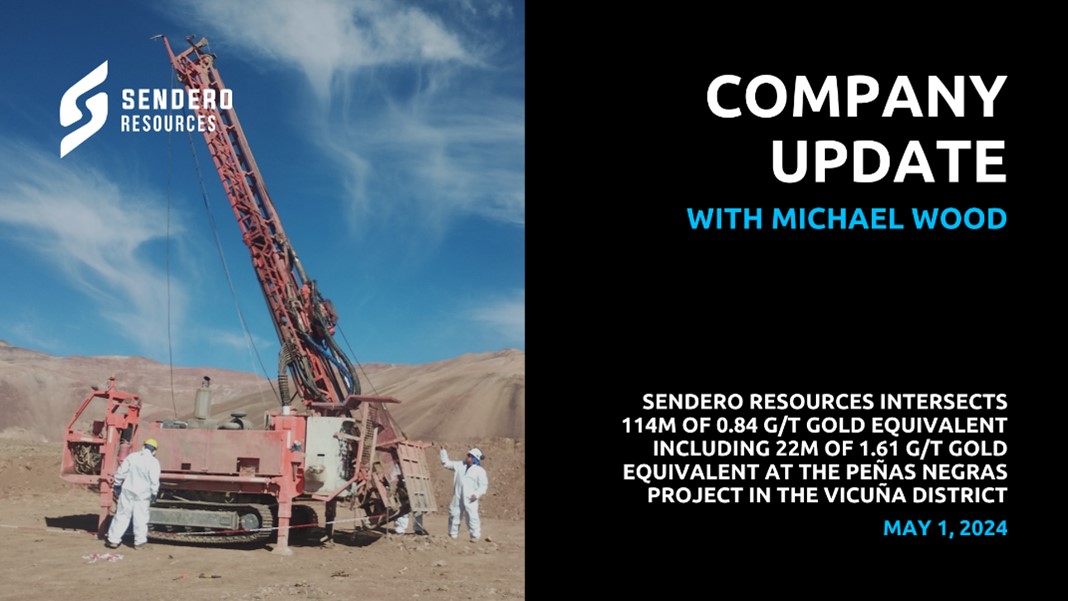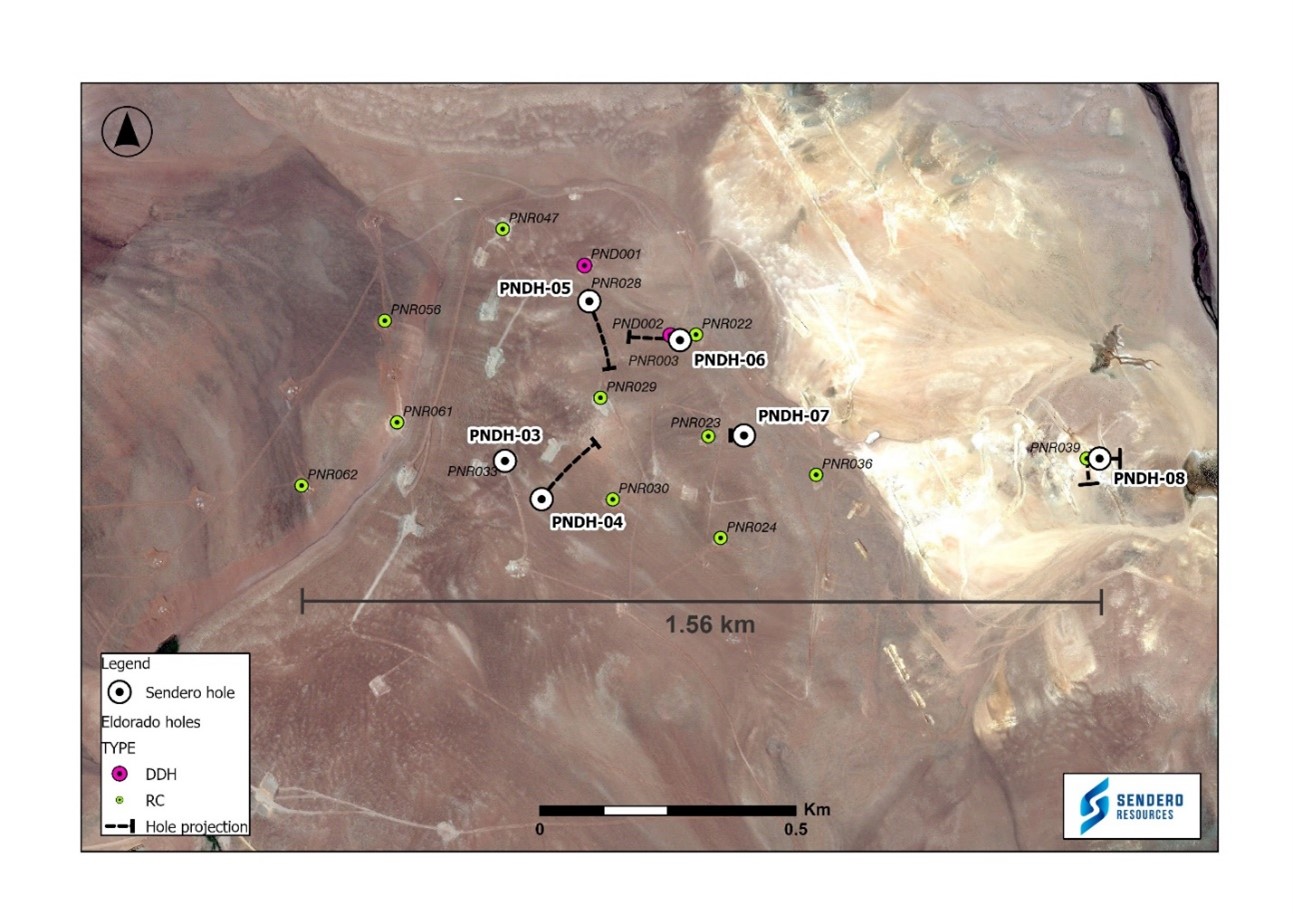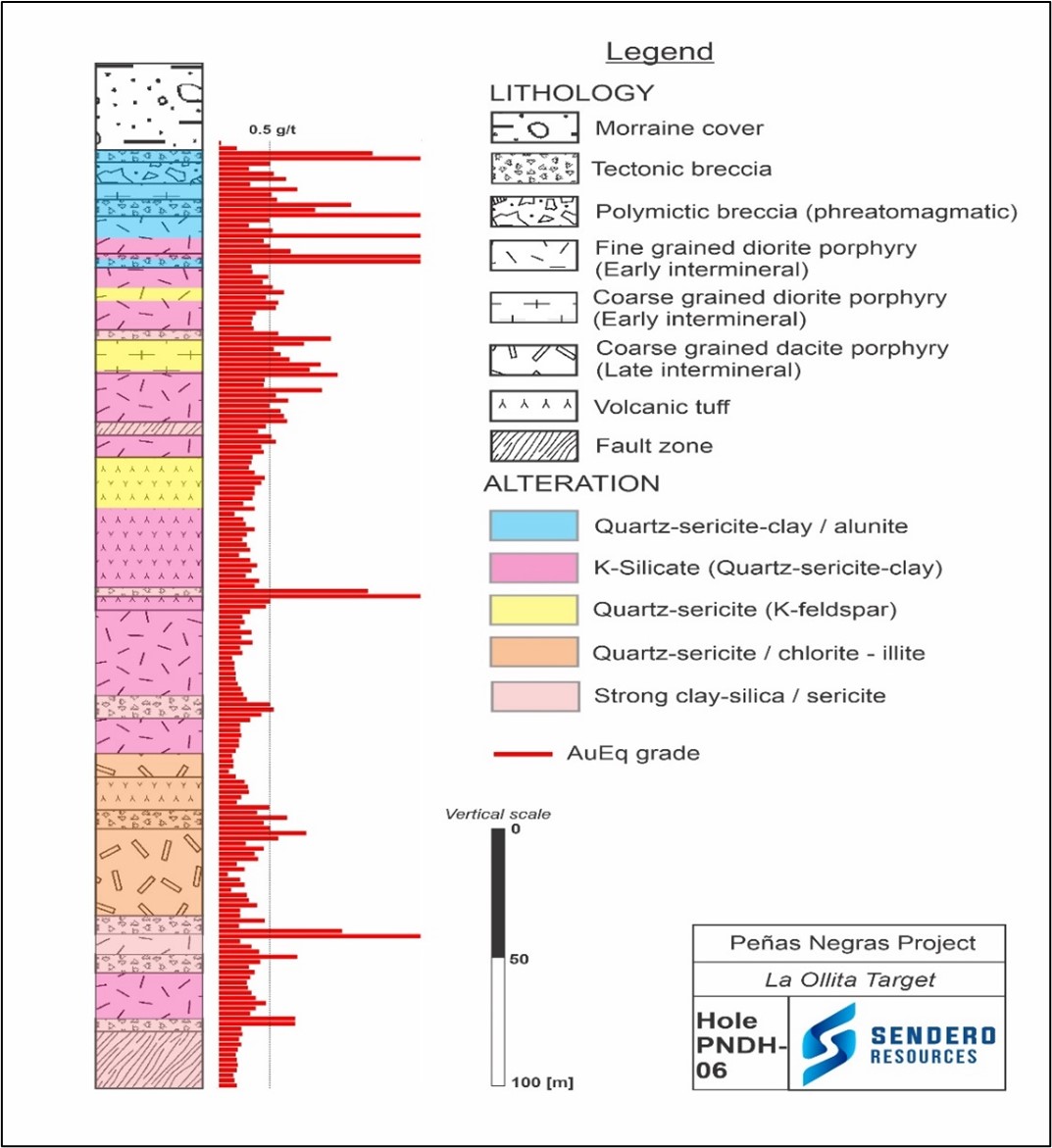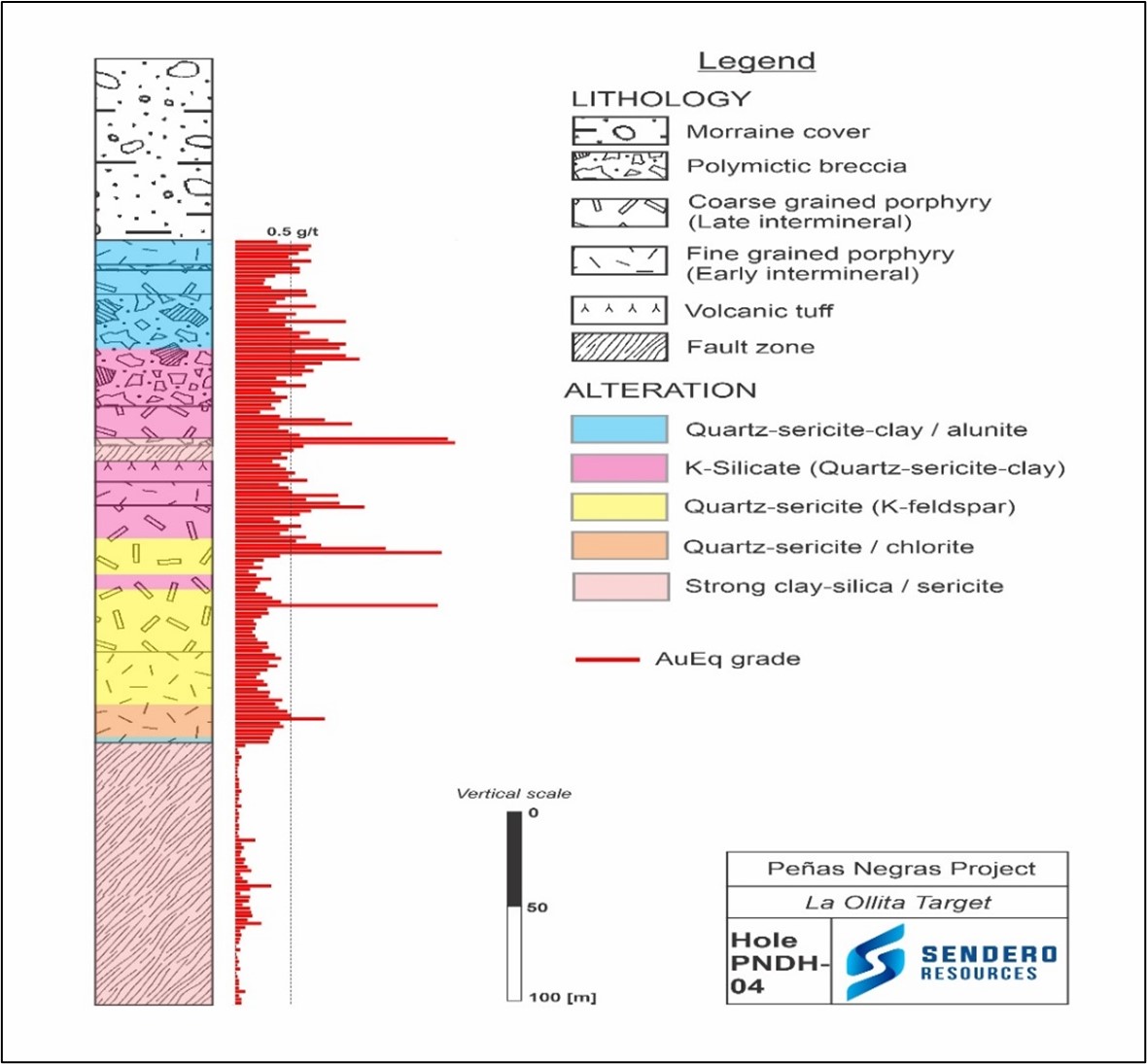VANCOUVER, BC / ACCESSWIRE / May 1, 2024 / Sendero Resources Corp. (TSXV:SEND) ("Sendero" or the "Company") is pleased to announce results of three more diamond drillholes from its maiden drilling program at its 100% owned Peñas Negras Project in the Vicuña District in La Rioja, Argentina. These latest results from holes PNDH004 to PNDH006 continue to demonstrate the significant potential of the project.
Highlights
- PNDH006 (La Ollita) intersected 364m of 0.51 g/t Gold Equivalent "AuEq" from a shallow depth of 34m to the bottom of the hole. The upper part of the hole intersected 114m of 0.84 g/t Gold Equivalent "AuEq" including 22m of 1.61 g/t AuEq
- PNDH004 (La Ollita) intersected 266m of 0.52 g/t AuEq from 96m to post-mineral fault zone. The upper part of the hole intersected 166m of 0.63 g/t AuEq including 72m of 0.72 g/t AuEq and 20m of 0.82 g/t AuEq
- Maiden drilling at La Ollita PNDH003-PNDH008 is confirming the presence of a large, high-level mineralized advanced argillic epithermal lithocap telescoped on a porphyry gold-copper system.
- All five holes drilled at La Ollita (PNDH003-PNDH008) ended in severe faulting with strong silica-sericite clay alteration, at what is considered to be the base of the large mineralized lithocap, and have not tested the porphyry system below.
- PNDH007 and PNDH008 (assays pending) designed to test the large magnetic anomalies intersected high levels of magnetite and in PNDH008 bornite replacement of the chalcopyrite was identified
- The exploration focus going forward at La Ollita is finding the high-grade feeder zone/s into lithocap and navigating out of the base of the lithocap to test the porphyry system below.
Sendero Executive Chairman, Michael Wood, commented:
"La Ollita is a large telescoped mineral system with multiple phases of porphyry and epithermal mineralization identified in our initial drilling. We are learning a great deal with each hole that is drilled and starting to find higher grade zones such as 22m of 1.61 g/t AuEq. The feeder zone into the advanced argillic lithocap is the big prize for us where the grade should be substantially higher and often where large amounts of the metals are contained within lithocap deposits.
We have seen extensive mineralization and alteration telescoping in holes 3, 4 and 6 with multiple phases of porphyry and epithermal mineralization identified, creating scale with continuous mineralization of 250m+ from beneath the moraine cover until we encountered the extensive fault zone at what we believe is the base of the lithocap, in all holes drilled to date at La Ollita."
Watch a news summary from Executive Chairman, Michael Wood below:


Figure 1: Plan View of La Ollita Drill Holes (PNDH003-008) with historic drill holes of significance
PNDH006
Hole PNDH006, showed telescoping of alteration and mineralization, intersecting a complex of porphyries, and associated phreatomagmatic breccias hosted in volcanic host rocks. The hole ended in mineralization at a depth of 398m for a total intersection of 364m averaging 0.51 g/t AuEq (Figure 2 and Table 1).
The alteration in the upper part of the hole is prominently advanced argillic, characterized by quartz-alunite-sericite with incipient vuggy quartz, which hosted the highest-grade mineralization including 22m of 1.61 g/t AuEq, with individual metal values of up to 1.28 g/t Au, 115 g/t Ag, 0.42% Cu, 4.73% Zn, 1.18% Pb and 195 ppm Mo.
Lower in the hole strong potassic alteration (K feldspar-biotite-magnetite) is observed, particularly in early porphyry dykes with high density quartz veinlets, superimposed by intense sericite-quartz. The late-stage porphyries, on the other hand, are chloritized with scarce to no quartz veining.
Primary mineralization consists of disseminated and quartz vein-hosted chalcopyrite, overlain by pyrite-chalcocite-black sulfides filling fractures and breccia matrix. Additionally, numerous intermediate sulfidation epithermal veins have been identified, composed of quartz and massive sulfides, predominantly galena and sphalerite together with elevated gold, silver and zinc values. The hole ended in a fault zone with strong silica-sericite clay alteration, the believed base of the lithocap.

Figure 2: PNDH006 La Ollita - Grade Distribution, Lithology and Alteration
PNDH004
Hole PNDH004 exhibits similar characteristics to Hole PNDH006 with telescoping of the alteration and mineralization from beneath the moraine cover returning an intersection of 266m averaging 0.52 g/t AuEq. Mineralisation terminated when a large post-mineral fault zone was encountered with strong silica-sericite clay alteration at 362m (Figure 3 and Table 2).
The upper part of the hole intersected a series of porphyries exhibiting potassic alteration (K feldspar and biotite). An early intermineral porphyry with intense porphyry style quartz veining was recognized as well as a late-stage porphyry with minimal quartz veining. Associated phreatomagmatic breccias were also observed. There is an intense general overprinting by epithermal-style advanced argillic alteration, represented by the association of sericite-quartz-alunite-pyrophyllite in the upper part of the hole. This telescoped alteration hosts the highest-grade mineralization including an intercept of 166 m of 0.63 g/t AuEq (see Table 2). Individual metals values up to 0.55 g/t Au, 0.3% Cu and 193 ppm Mo are related to epithermal overprint on early-stage porphyry mineralization, while individual values up to 1.51 g/t Au, 19 g/t Ag, 2.26% Zn and 1.04% Pb are related to late-stage intermediate sulphidation veins and epithermal-related mineralization (black sulfides) filling breccias.
Lower in the hole begins a transition to sericite-illite-clays overprinting the K silicate alteration, hosting Au-Ag-Cu-Mo mineralization with lower grades extending to 362 m where the hole entered a large post-mineral fault zone with strong silica-sericite clay alteration, the believed base of the lithocap (Figure 3).

Figure 3: PNDH004 La Ollita - Grade Distribution, Lithology and Alteration
PNDH005
Hole PNDH005, after penetrating the moraine cover, intersected mostly fine volcanic tuff of andesitic composition, with extensive evidence of tectonic activity manifested by wide intervals of tectonic breccias hosting Au-Ag-Zn-Pb mineralization.
The alteration observed is silica-clay to advanced argillic, characterized by the general association of quartz-sericite-alunite-clays, displaying a distinct spotty and wormy texture down to a depth of 193 meters. Minor remnants of K feldspar are suggestive of early potassic alteration. The mineralization is mostly late-stage, disseminated and within microfractures and breccias, consisting of pyrite + black sulfides containing Ag-Zn-Pb, with minor amounts of chalcopyrite.
PNDH005 was drilled in a more northern part of the target and Au-Cu-Ag grades did pick up as the hole moved further south with the highest grades present in zones of intense fracturing generating crackle breccias in the volcanic rocks, as well as zones of tectonic breccias (pre-mineral faults). These zones returned intersections of 24 meters grading 0.52 g/t AuEq, 38 meters at 0.60 g/t AuEq and 12 meters at 0.78 g/t AuEq. (Table 3)
Next Steps
Drilling for the season was completed for a total of 3,124m across 8 holes with results from holes PNDH007 and PNDH008 pending, with depths of 95m and 88m, respectively. PNDH007 was designed to test the centre of the central magnetic anomaly at La Ollita, while PNDH008 was designed to test the centre of the eastern magnetic anomaly. Both are sizable magnetic anomalies that are untested by drilling. However difficult drilling conditions, including heavily fractured rock with strong silica-sericite clay alteration at the base of the lithocap, resulted in both holes being stopped before testing the magnetic anomalies. However, both holes showed very encouraging signs, with both showing high-levels of magnetite and in PNDH008 bornite replacement of the chalcopyrite was identified. These porphyry targets, below the base of the lithocap, are priority targets to be tested in the next drill program with zoning around the central magnetic anomaly suggesting it could be the potential centre of the system and a possible high-grade feeder zone.
The Company plans to complete a geophysical program at La Ollita to gain a greater understanding of the system at depth, guiding towards the feeder zone/s of the lithocap at La Ollita and to navigate the extensive faulting seen at the base of the lithocap to test the porphyry complex below. The Company is planning to conduct a Magnetotelluric (MT) survey, which is a geophysical approach that has been used successfully elsewhere in the Vicuña District, such as at Filo Del Sol, to identify feeder zones and navigate the base of the lithocap to test porphyries at depth. The feeder zones into the lithocap can potentially be a fault and/or an intrusive porphyry body. They typically carry higher metal grades than the lithocap itself and often host most of the metal in the system. Therefore, finding the feeder zones and navigating out of the base of the lithocap are the priority exploration goals for the Company now at La Ollita.
Table 1: PNDH006 Drill Highlights

Table 2: PNDH004 Drill Highlights

Table 3: PNDH005 Drill Highlights

Note: Gold Equivalent Values ("AuEq") are based on metals prices of $2000/oz Au $4/lb Cu, $25/oz Ag, $20/lb Mo, $1.30/lb Zinc and $1/lb lead and recovery is assumed to be 100% as no metallurgical data is available.
Click here to see Historical Drill Assays.
Click here to see Drill Collar information.
About Sendero Resources Corp.
The Company is focused on copper-gold exploration at its 100% owned Peñas Negras Project in the Vicuña Belt in Argentina. The Peñas Negras Project has similar geological characteristics to other deposits in the Vicuña Belt and a cluster of porphyry and epithermal targets have been identified on the project. The Company, through its wholly owned subsidiary, Barton SAS, is the holder of ten granted mining concessions covering 120 km2 in the province of La Rioja, Argentina. The company also has an option agreement to earn 80% interest on eight granted mining concessions covering 91.7 km2 adjacent to the East of the Peñas Negras Project. The Company has an experienced management and exploration team who will use their expertise and operational knowledge to advance the multiple targets across the project.
Further Information
For further information, please contact:
Sendero Resources Corp.
Michael Wood, Executive Chairman
Email: michael@senderoresources.com
Forward-Looking information
This press release contains "forward-looking information" and "forward-looking statements" (collectively, "forward-looking statements") within the meaning of applicable Canadian securities legislation. All statements, other than statements of historical fact, are forward-looking statements and are based on expectations, estimates and projections as at the date of this press release. Forward-looking information herein includes, without limitation, statements regarding the potential grade and quantity of deposits on the Property, the Company's anticipated drilling program and results of its current further drilling program, the inferred geometry and mineralization of the Property, and the development of the Property and prospects thereof. Any statement that involves discussions with respect to predictions, expectations, beliefs, plans, projections, objectives, assumptions, future events or performance (often but not always using phrases such as "expects", or "does not expect", "is expected" "anticipates" or "does not anticipate", "plans", "budget", "scheduled", "forecasts", "estimates", "believes" or intends" or variations of such words and phrases or stating that certain actions, events or results "may" or "could, "would", "might" or "will" be taken to occur or be achieved) are not statements of historical fact and may be forward-looking statements. Forward-looking statements are necessarily based upon several estimates and assumptions that, while considered reasonable, are subject to known and unknown risks, uncertainties, and other factors which may cause the actual results and future events to differ materially from those expressed or implied by such forward-looking statements. Such factors include, but are not limited to; general business, economic, competitive, political and social uncertainties; the delay or failure to receive shareholder, director or regulatory approvals; and actual results of exploration at the Peñas Negras Project which may differ from anticipated results. There can be no assurance that such statements will prove to be accurate, as actual results and future events could differ materially from those anticipated in such statements. Accordingly, readers should not place undue reliance on the forward-looking statements and information contained in this press release. Except as required by law, the Company does not assume any obligation to update the forward-looking statements of beliefs, opinions, projections, or other factors, should they change, except as required by law.
QA/QC Statement
Sendero Resources follows industry standard diamond core drilling and sample analysis procedures. Drilling is done with PQ and HQ-size tools. The drill core is cut in half with a diamond rock saw and then half of the core is taken as a sample for analysis and the other as a log. Sampling intervals are 2 m intervals, producing samples between 5 and 15 kg. Half-core samples are transported to Alex Stewart's internationally certified laboratory facility in Mendoza, Argentina where the samples are prepared. Alex Stewart has a quality management system (ISO 17025), and testing is performed in Mendoza, Argentina. Samples are fire tested for Au (Au4-30) and analyzed for Ag and multiple elements using the ICP method code (ICP-MA 39) after digestion with 4 acids (HF, HClO4, HNO3 and HCl). Over limits are analyzed using an appropriate method (ICP-ORE). Multi-element geochemical standards and blanks or duplicates are inserted systematically every 10 regular samples, having 10% QA/QC control samples per hole, thus monitoring the laboratory performance. The control samples are inserted in a blank, standard and duplicate pattern. The standard is chosen between low, intermediate or high grade (Au-Cu) according to the geology observed in the corresponding interval. In reference to the chain of custody, the samples are transported from Peñas Negras by Sendero Resources personnel to Alex Stewart's laboratory in Mendoza Argentina.
Qualified Person
David Royle (FAusIMM (CP)) supervised the preparation of and reviewed and approved the scientific and technical information pertaining to Peñas Negras Project contained in this news release. David Royle has reviewed the sampling and QA/QC procedures and results as verification of the data disclosed in this news release. David Royle is a qualified person as defined by National Instrument 43-101 - Standards of Disclosure for Mineral Projects.
Neither the TSX Venture Exchange nor its Regulation Services Provider (as that term is defined in the policies of the TSX Venture Exchange) accepts responsibility for the adequacy or accuracy of this release.
NOT FOR DISTRIBUTION TO U.S. NEWSWIRE SERVICES OR FOR RELEASE, PUBLICATION, DISTRIBUTION OR DISSEMINATION DIRECTLY, OR INDIRECTLY, IN WHOLE OR IN PART, IN OR INTO THE UNITED STATES.
SOURCE: Sendero Resources Corp
View the original press release on accesswire.com














